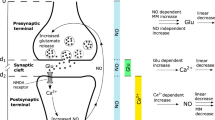Abstract.
This work sets out to investigate fast and slow dynamic processes and how they effect the induction of long-term potentiation (LTP). Functionally, the fast process will work as a time window to take a spatial coincidence among various inputs projected to the hippocampus, and the slow process will work as a temporal integrator of a sequence of dynamic events. Firstly, the two factors were studied using a “burst” stimulus and a “long-interval patterns” stimulus. Secondly, we propose that, for the induction of LTP, there are two dynamic processes, fast and slow, which are productively activated by bursts and long-interval patterns. The model parameters, a time constant of short dynamics and one of long dynamics, were determined by fitting the values obtained from model simulation to the experimental data. A molecular factor or cellular factors with these two time constants are likely to be induced in LTP induction.
Similar content being viewed by others
Author information
Authors and Affiliations
Additional information
Received: 3 November 1997 / Accepted in revised form: 18 August 1999
Rights and permissions
About this article
Cite this article
Aihara, T., Tsukada, M. & Matsuda, H. Two dynamic processes for the induction of long-term potentiation in hippocampal CA1 neurons. Biol Cybern 82, 189–195 (2000). https://doi.org/10.1007/s004220050018
Issue Date:
DOI: https://doi.org/10.1007/s004220050018




